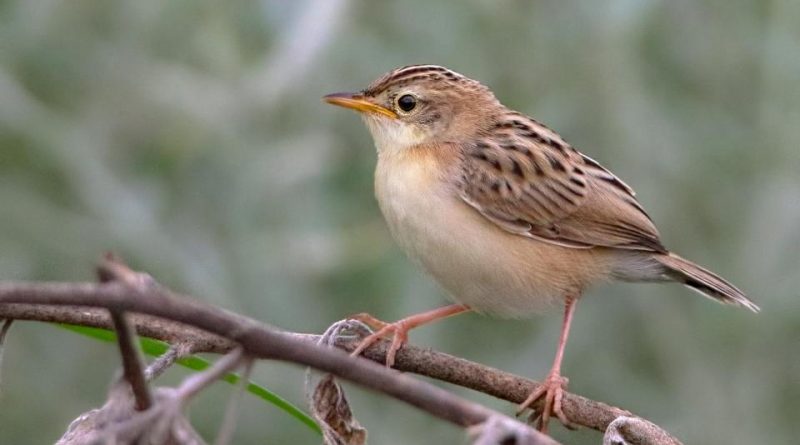Cisticola juncidis
Cisticola juncidis
The Zitting Cisticola (Cisticola juncidis Rafinesque, 1810) is a passerine bird belonging to the Cisticolidae family.
Systematic –
From a systematic point of view, it belongs to the Eukaryota Domain, Animalia Kingdom, Sub-Kingdom Eumetazoa, Superphylum Deuterostomia, Phylum Chordata, Subphylum Vertebrata, Infraphylum Gnathostomata, Superclass Tetrapoda, Aves Class, Subclass Neornithes, Superorder Neognathae, Suborder, Passorder. Sylvioidea, Family Cisticolidae and therefore to the Genus Cisticola and the Species C. juncidis.
Of this species, 17 subspecies have been identified, which are listed below:
– C. j. brunniceps (Temminck & Schlegel, 1850) – South Korea, Japan and Batan (northern Philippines);
– C. j. cisticola (Temminck, 1820) – western France, Iberian Peninsula, Balearic Islands, Pantelleria, Lampedusa and north-western Africa;
– C. j. constans Stresemann, 1938 – Sulawesi and neighboring islands;
– C. j. cursitans (Franklin, 1831) – From eastern Afghanistan to northern Burma and southern China and southern and south-eastern India, to the arid lowlands of Sri Lanka;
– C. j. fuscicapilla Wallace, 1864 – East Java, Kangean and smaller Sunda islands;
– C. j. juncidis (Rafinesque, 1810) – From southern France to Turkey and Syria, Egypt and large Mediterranean islands;
– C. j. laveryi Schodde & Mason, 1979 – northeastern Australia, possibly southern New Guinea;
– C. j. leanyeri Givens & Hitchcock, 1953 – north-central Australia;
– C. j. malaya Lynes, 1930 – Nicobar Islands Southeastern Burma, Southwestern Thailand, Malay Peninsula and main Sunda islands;
– C. j. neuroticus Meinertzhagen, 1920 – From Cyprus, Lebanon and Israel to western Iran;
– C. j. nigrostriatus Parkes, 1971 – Palawan;
– C. j. Normans Mathews, 1914 – From north-western Queensland (north-eastern Australia);
– C. j. omalurus Blyth, 1851 – Sri Lanka (except arid lowlands);
– C. j. salimalii Whistler, 1936 – Southwest India;
– C. j. terrestris (Smith, A, 1842) – From Gabon and Congo to southern Tanzania and South Africa;
– C. j. tinnabulans (Swinhoe, 1859) – From southeastern China to Taiwan and Thailand, Indochina and the Philippines (except Batan and Palawan);
– C. j. uropygialis (Fraser, 1843) – From Senegal and Gambia to Ethiopia, Rwanda, Tanzania and Nigeria.
Geographical Distribution and Habitat –
The Zitting Cisticola is a species present in an area between the equatorial, tropical and subtropical regions, from Africa to Australia, passing through China and Japan. In Europe it is concentrated mainly in the Mediterranean area and, during the cold season, it moves to the southern part of the area, until it reaches North Africa.
In Italy the species is particularly common in the Po valley, but it is present in almost all the peninsula, except for the Alps and the innermost Apennine reliefs. The populations present in the islands of Pantelleria and the Pelagie islands belong to the subspecies Cisticola juncidis cisticola.
Its habitat is mainly linked to nesting sites which are represented by open areas, such as pastures, cultivated areas, and prairies, never above the hilly level.
Description –
The Zitting Cisticola is a small bird 10-11 cm long, with a wingspan of 15-16 cm and a weight of 8-9 gr.
Species with zero sexual dimorphism, with juveniles very similar to adults and in which the male and the female have a practically identical livery with brown – fawn color on the whole body, lighter in the lower parts, with dark and light streaks on the back and on the boss.
The beak is slightly curved downwards, pink – orange in the lower part.
The legs are pink – yellow.
Biology –
Cisticola juncidis is a bird in which the male, in the reproductive season, which runs from May to July, begins to build several nests where it attracts the females. The pouch-shaped nest is suspended inside a tuft of grass.
After mating, the female completes the construction of the nest, which takes the shape of an elongated cup or a baby carrier, and lays 4 to 6 eggs there.
The incubation period lasts around 10-11 days and after about 2 weeks after hatching the young are usually able to leave the nest.
Ecological role –
The Zitting Cisticola is a species that feeds on insects and is also granivorous.
During the breeding season, the males have a typical zigzag flight, accompanied by regular vocalizations compared to the repeated cuts of a scissor.
According to the IUCN, the area of the Italian population is large (greater than 20000 km² – 2002). The number of mature individuals is estimated at 200,000-600,000 and has increased in the period 2000-2010. The species therefore does not reach the conditions to be classified within one of the threat categories (population decline of 30% in three generations, reduced number of mature individuals, restricted area) and is therefore classified as a minor concern (LC).
The threats are however related to habitat loss and the use of pesticides.
Guido Bissanti
Sources
– Wikipedia, the free encyclopedia.
– C. Battisti, D. Taffon, F. Giucca, 2008. Atlas of nesting birds, Gangemi Editore, Rome.
– L. Svensson, K. Mullarney, D. Zetterstrom, 1999. Guide to birds of Europe, North Africa and the Near East, Harper Collins Editore, United Kingdom.


